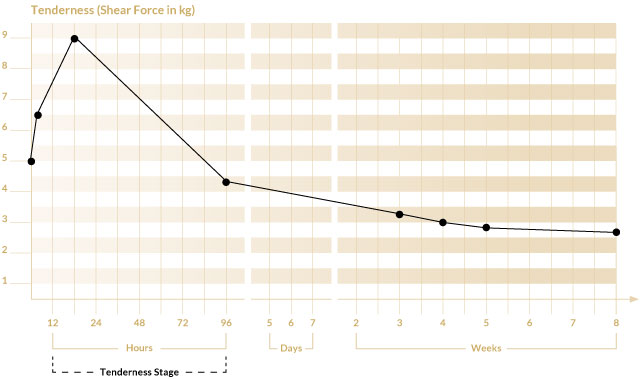back
KNOW HOW
THE SCIENCE OF DRY AGING
Unless you like chewing on boot-leather beef, proper aging is necessary for any type of meat to be enjoyed properly, whether it is beef, pork, lamb, duck or any other animal. During the aging process, organic chemical forces come into play, transforming the tough and rather flavorless post-harvest carcass to the tender, juicy and exceptionally flavorful meat we all know and love.

Undoing the effects of Rigor Mortis
After the animal is slaughtered, a series of changes occur once oxygen is no longer available to the meat. In the absence of oxygen, glycogen and glucose in the anaerobic environment break down into lactate, resulting in the hardening of the muscle tissue known as fibrilla. Consequently, the meat becomes tough, firm, dry and unpalatable. In cattle, this phenomenon, referred to as rigor mortis, typically sets in within 10-24 hours. In pigs, it occurs in 4-18 hours, while in chickens, it takes 2-4 hours. Only after this period does enzymatic meat aging commence.
Enzymes break it down and create tenderness
Enzymes play a crucial role in making the meat tender during the aging process. The enzymatic ripening of the meat can span from 1 to 8 days, depending on the species. The production of lactic acid during anaerobic glycogenolysis is vital for successful maturation. Lactic acid acts on the muscle fibers, breaking down the structure with the help of protein-cleaving enzymes called proteases. This loosens the cellular bonds, allowing proteolytic enzymes to act on the muscle tissue and break down the hardened muscle. As a result, the meat becomes tender once again.

Amplify the Umami
Dry-aging, which can take anywhere from 3 to 8 weeks, is employed to develop the desired nutty and buttery flavors that cannot be achieved with shorter aging times. During dry-aging, oxidation and water evaporation lead to the formation of a crust, beneath which the enzymes and proteins work their magic, infusing the meat with distinct flavors and aromas.
In contrast, wet-aging involves a shorter period of vacuum sealing, resulting in a flavor profile dominated by lactic acid. Dry-aging, on the other hand, allows for the maturation of lactic acid into a spicy flavor and the natural development of glutamate, enhancing the meat's taste with a deeper, umami flavor.
BRING YOUR DRYAGER™ UNIT TO YOUR HOME AND JOIN OUR FAMILY
As soon as you have received your DRYAGER™ device you can register to myDRYAGER and get exclusive access to more video tutorials, know how articles and much more.
back



